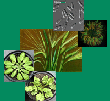| Bendix, J; Silva, B; Roos, K; Göttlicher, D; Rollenbeck, R; Nauß, T; Beck, E: Model parameterization to simulate and compare the PAR absorption potential of two competing plant species, International Journal of Biometeorology, 54(3), 283-295 (2009), doi:10.1007/s00484-009-0279-3 | |
| Abstract: Mountain pastures dominated by the pasture grass Setaria sphacelata in the Andes of southern Ecuador are heavily infested by southern bracken (Pteridium arachnoideum), a major problem for pasture management. Field observations suggest that bracken might outcompete the grass due to its competitive strength with regard to the absorption of photosynthetically active radiation (PAR). To understand the PAR absorption potential of both species, the aims of the current paper are to (1) parameterize a radiation scheme of a two-big-leaf model by deriving structural (LAI, leaf angle parameter) and optical (leaf albedo, transmittance) plant traits for average individuals from field surveys, (2) to initialize the properly parameterized radiation scheme with realistic global irradiation conditions of the Rio San Francisco Valley in the Andes of southern Ecuador, and (3) to compare the PAR absorption capabilities of both species under typical local weather conditions. Field data show that bracken reveals a slightly higher average leaf area index (LAI) and more horizontally oriented leaves in comparison to Setaria. Spectrometer measurements reveal that bracken and Setaria are characterized by a similar average leaf absorptance. Simulations with the average diurnal course of incoming solar radiation (1998–2005) and the mean leaf–sun geometry reveal that PAR absorption is fairly equal for both species. However, the comparison of typical clear and overcast days show that two parameters, (1) the relation of incoming diffuse and direct irradiance, and (2) the leaf–sun geometry play a major role for PAR absorption in the two-big-leaf approach: Under cloudy sky conditions (mainly diffuse irradiance), PAR absorption is slightly higher for Setaria while under clear sky conditions (mainly direct irradiance), the average bracken individual is characterized by a higher PAR absorption potential. (∼74 MJ m−2 year−1). The latter situation which occurs if the maximum daily irradiance exceeds 615 W m−2 is mainly due to the nearly orthogonal incidence of the direct solar beam onto the horizontally oriented frond area which implies a high amount of direct PAR absorption during the noon maximum of direct irradiance. Such situations of solar irradiance favoring a higher PAR absorptance of bracken occur in ∼36% of the observation period (1998–2005). By considering the annual course of PAR irradiance in the San Francisco Valley, the clear advantage of bracken on clear days (36% of all days) is completely compensated by the slight but more frequent advantage of Setaria under overcast conditions (64% of all days). This means that neither bracken nor Setaria show a distinct advantage in PAR absorption capability under the current climatic conditions of the study area. |

